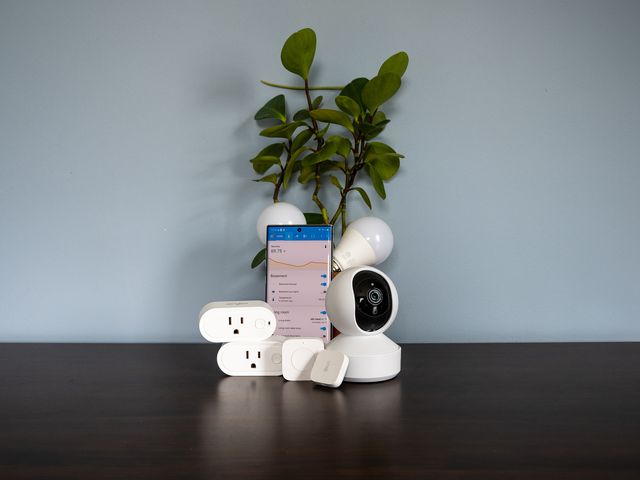Any aspiring smart home junkie eventually hits what I call the Smart Wall. You'll ask yourself a question like "How do I set my Nest thermostat to have a two-degree temperature window?" You do a little research, and uncover the horribly simple answer: You can't!
There are two roads away from here. You could move on with your life! Or you could dig in. There must be some way. It should be possible! It's with some trepidation that I reveal to you the forbidden truth: It is almost always possible — it's just... well, it's very complicated.
Part of what makes it possible is Home Assistant, a free, open-source home automation application. Most smart home gadgets prefer (or require) that you use their parent company's app and cloud infrastructure. Home Assistant provides a path out of walled gardens and enables all kinds of advanced possibilities by acting as a translator and providing a lingua franca for devices that otherwise cannot communicate. The result? Control (almost) any device with (almost) any other based on (almost) any conditions you want, and control them all from one single app.
I found Home Assistant after trying to view my Wyze cameras inside the Google Home app. (You can’t). But with Home Assistant, I can see everything in one place, but that’s not all. My crowning smart home achievement? I have button on my nightstand that unites a half-dozen brands to turn off every light in the house and lock the front door if I press it between 9 PM and midnight. Between 4 and 7 AM, it turns on my living room lights to 50 percent brightness until the sun comes up. Then, they get brighter or turn off, depending on the weather.
Sound good? I bet! But beware: Home automation on this level becomes a hobby in and of itself. Allow me to prepare you for what it entails. Start by asking yourself a few questions:
- Am I excited by the prospect of running a "server" in my home?
- Can I imagine myself "flashing custom firmware" or "generating an API key"?
- Can I hear myself saying sentences like "I'm sorry honey, I'd love to watch a movie but we both know I need to debug the bathroom lights"?
Yes? I cannot begin to explain the process in details. It varies from home to home, and Home Assistant's documentation and forums will serve you much better.
I can, however, give you a broad overview of what the process entails. It's either simpler or more complicated than it sounds. You'll find out which if you give it shot.
Step 1: Set Up a Server
In contrast to The Cloud, Home Assistant runs on a device you own. This means you have control over your data, and many devices can operate smartly even without any internet. The cost is that you have to have some sort of server — a dedicated, always-on device — in your home to run it.
Solutions vary. If you have a Network Attached Storage (NAS) device, odds are it can operate as a Home Assistant server. Looking for an excuse to buy something new? A Home Assistant server runs great on a Raspberry Pi. Got an old laptop lying around? Even relatively ancient hardware is up to the task.
I use an old Surface Pro which lives, never sleeping, in the cabinet of my TV stand. It works fine! Except for when it glitches and my lights turn on at 2 AM. I'm working on a fix.
Apple's HomeKit notably provides similar, simpler functionality, with a HomePod or Apple TV as the server. It's a decent but more limited alternative, perfect for normies and cowards.
Step 2: Integrate Your Proprietary Products
Most smart home devices can be controlled by means other than their official app. Gadget makers create software called "APIs" (short for Application Programming Interface) which let "developers" access devices through complicated interfaces for the purpose, ostensibly, of developing apps. When you mess around with Home Assistant, you become such a developer, and the app is your house.
Home Assistant has "integrations" that streamline the process of linking various devices to your server, as well as a community-run app store of sorts, with add-ons that support even more.
The ease of use is...uneven at best. Some devices will work automagically when Home Assistant sees them on your Wi-Fi. Others (like, Google's Nest) require you to pay a one-time fee for access to an API that is difficult to set up, even for the technically astute. Still others (like Wyze devices) only work with Home Assistant via unsupported loopholes in their parent companies' infrastructure that could be closed, breaking compatibility, at any time.
Step 3: Make Smart Choices
If you want to dabble in Home Assistant, do it before you invest in any more new gadgets. Home Assistant will work with the bulk of smart home devices you already own, but it will change your priorities.
I used to opt for devices that connect over Wi-Fi because they don't require buying a specialized "hub." Now I've done a 180. I much prefer devices that use the hub-based "Zigbee" networking because Home Assistant allows me to run my own hub and control these devices internet-free with a high degree of fidelity. (When it works.) You may have heard a lot of hubbub about upcoming smart home standards "Matter" and "Thread," but there's little they offer that Home Assistant does not already provide.
If you want to know more, there's really no substitute for diving in head first. If you don't, that's fair, too, and maybe slightly more sane. But have fun standing up to turn off the lights, chump.
The Smart Home Starter Kit
Everyone’s place is different, but here are some of the workhorses in my setup.























